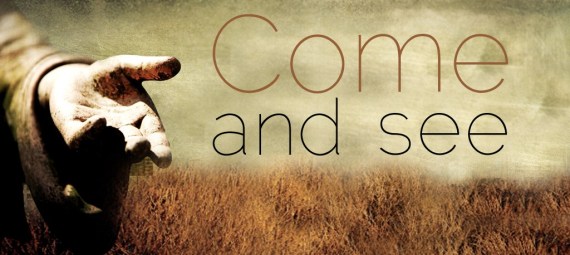“Come and see” is one of the most common evangelical themes I hear for Orthodox Churches. It comes directly from last Sunday’s Gospel reading.
But, the “see” part seems contradictory to scripture, which emphasizes “hearing” the gospel.
In addition, the Church calls us to bring people to Christ, yet, “come and see” is about “seeing” us, what we do in church. And, how do people see Christ today if he’s been resurrected into heaven? What are people supposed to see, exactly?
Sunday’s Good News isn’t a message for outsiders to come and see what we do, but a call for us to follow Christ on the path to the Kingdom! It’s a calling for us to meet people where they are.
In Sunday’s reading, Jesus recruits one of his first disciples: Philip. And, it isn’t long before Philip becomes the first evangelist.

The text says that Philip found Nathanael and, immediately, he began to tell him about Jesus . . . how Jesus is the subject of the Law and Prophets of the Old Testament.
Nathanael wasn’t convinced.
In response, Philip utters that famous phrase, “Come and see.”
I’ve seen this phrase used a lot, especially for evangelism.
Banners that hang on the side of churches have used it, and people encouraging their friends, or even strangers, to come to church have used it
Yet, it occurs to me that there might be a few problems with “come and see.”
The first problem is the emphasis on seeing.
As you comb through scripture, it’s clear that God isn’t about people seeing what he does.
Instead, he wants us to hear his story.
- We are to hear about how he freed the Israelites from bondage.
- He wants us to hear about how he lead them through the desert.
- And, we are to hear about how he made them his people and cared for them.
He wants us to hear his commandments and obey them.
[The Lord said,] “Assemble the people. I want them to hear what I have to say, so that they will learn to obey me as long as they live and so that they will teach their children to do the same.” (Deuteronomy 4:10)
“Tell the mountains of Israel to hear the Sovereign Lord’s word—to hear what I, the Sovereign Lord, am telling the mountains, the hills, the gorges, and the valleys . . .” (Ezekiel 6:3)
“So then, anyone who hears these words of mine and obeys them is like a wise man who built his house on rock.” (Matthew 7:24)
“My ambition has always been to proclaim the Good News in places where Christ has not been heard of . . .” (Romans 15:20)
So, is John mixed-up when he tells us that Philip wanted Nathanael to “come and see”?
The second problem is what we mean when we ask people to “come and see.”
We want to bring people to Christ so that they will be transformed and find union with God.

But, when we use this phrase, what we often mean is: come and see us. See how we do liturgy, see how beautiful ouricons are, see us practice our religion–isn’t it wonderful!
This strikes me as . . . well . . . a bit egotistical.
Shouldn’t the emphasis be on Christ rather than on what we’re doing?
Shouldn’t we “pray in secret” as the gospel last week exhorted us to do?
But still, we’re still called to “baptize all nations” . . . right?
So, if “come and see” isn’t a tag line for advertising ourselves, what does it mean?
I think a deeper reading of the text give us the answer.
If we follow the story as John lays it out, we see that Nathanael wasn’t surprised that Philip had found the Anointed One, the Messiah, the Christ.
He’s actually surprised by where Philip finds him.
Nathanael expected the Messiah to be in Jerusalem, not Nazareth.
After all, Jerusalem was the City of David, the capital, and the place where the Temple stood. To most Judeans, Jerusalem was a sacred city, with a sacred history, and an expected sacred future.
In fact, Jesus confirmed this was the case. He tells Nathanael,
“I saw you when you were under the fig tree.” (John 1:48)
The “fig tree,” you see, is symbolic language. It stands for Jerusalem and the Temple system.
Jesus’s statement tells us that Israel put its trust in the system rather than in God.
They believed that Temple was the way to God, but it was caught up in politics. Those who ran the Temple had abandoned God’s vision for Israel–this is why God exiled them in the Old Testament.

Those who ran the Temple, as well as King Herod, cooperated with the Romans. They believed this was the path to salvation. After all, “son of god” originally referred to Caesar, not Jesus.
But, Jesus challenged all this.
He challenged everything that the Temple stood for–the presence of God, the release of sins through the sacrificial system, and its political significance.
Jesus puts the Temple under judgment–in fact, Jesus cleanses the Temple in the very next chapter!
Now Jesus, not the Temple, is the way to God, the path to salvation. Jesus is the true “son of God.”
So, “come and see” is not a reference to meeting God in Jerusalem, at the Temple, but to see how God is working outside of Jerusalem . . . outside of our expectations!
For us today, it’s calling to see how God is working outside our own church walls . . . outside of the brick and mortal structures we build.
When Philip asked Nathanael to “come and see,” it was an invitation to follow Jesus, not to come and see a ceremony in a building in a sacred city.
As the hearers of this Gospel passage today, Jesus’s statement, “come and see,” is now directed at us!
Jesus isn’t giving us business advice. He’s not saying “come and see” to outsiders, but he’s calling us, who are already in the pews.

He’s calling us to see the path to the Kingdom . . . the path to the cross.
Like Paul, the great evangelizer who traveled all around the ancient Mediterranean world, Jesus calls us to get out from under the shade tree that gives us comfort and go out into the world.
Jesus asks us to abandon the temples, buildings, and physical structures we put up that serve our false gods and idols.
Following Jesus isn’t easy. He once said,
“Foxes have holes, and birds have nests, but the Son of Man has no place to lie down and rest.” (Luke 9:58 GNT)
Yet, Jesus still calls us to follow him to the cross.
This is no easy task. But, if we choose to pick up our cross and follow him, we’ll witness his promise.
“I am telling you the truth: you will see heaven open and God’s angels going up and coming down on the Son of Man.” (John 1:51)
“Come and see,” brothers and sisters, is not about outsiders coming to see us, but a call for us to get up and go out into the world to follow Christ.
It’s a calling to seek the transformation of the world through Christ’s love.
So, I’m wondering . . .
What “temples” have you built to false gods? And, what institutions do you put your faith in instead of Christ?
What action is God calling you to do in order to follow him this week?
How will you get up and see what God is doing in the world, and how will you be a part of God’s great act of transformation?

















